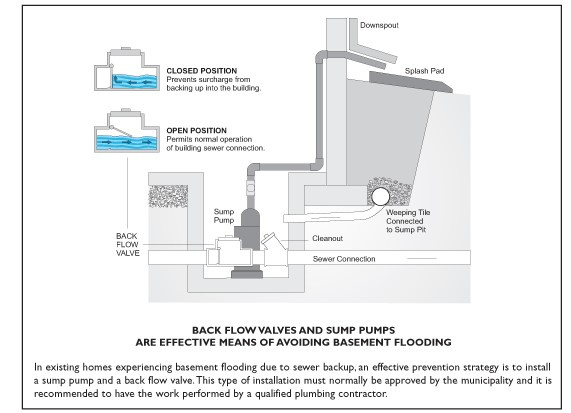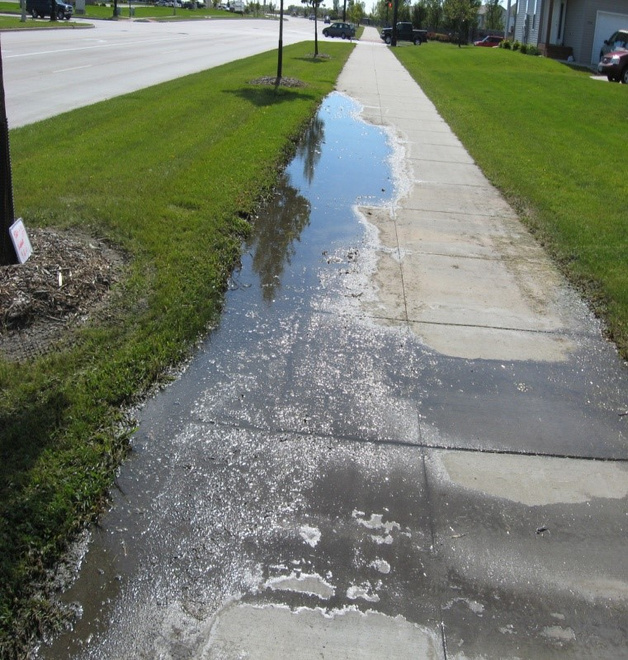Frequently asked questions
How can I run my sump pump outside during the winter? It kills the grass and freezes the hose.
The first thing to do is make sure that your water softener is not connected to your sump pump. Softener discharge has a very high salt content that kills the grass and will leave stains on the concrete. Second, do not have a long hose connected during the winter. A hose that is 8 -10 feet long will get the water away from the foundation and will clear itself each time it discharges. Be sure that the hose lays on ground that slopes away from the house. Check the hose so you are sure that the kids or the dog did not move the hose causing it to get kinked . A good cover of snow will help to insulate the hose. Spring thaws cause water to flow during the day and freeze at night. This may kill your grass. The same thing happens at your gutter downspouts. Quite often the grass will come back or you may have to re-seed a small patch in your yard. Too much of anything is not good. Move the hose often during the summer months.
Why is the City of Fargo so concerned with sump pump discharge into the sanitary system?
Our sanitary system covers an area 11.6 miles long and 4.7 miles wide. We are adding to this area each year. The City of Fargo hired consultants to study the future sanitary needs of our city. The studies found that sump pump discharge is a major contributor to the sanitary backups during the heavy rainstorms. They also found that Sump Pump discharge into the sanitary sewer limits how far the city can grow. We must reduce the unnecessary clear water being added to the system before we can accurately calculate the needs for future growth. Each neighborhood is designed to handle the sanitary needs for the number of people in that area. Adding clear water to the system reduces the design capabilities of that system.
Clear water must be processed with the same methods used to clean our Waste Water. The quality of this water is strictly regulated and controlled by the EPA and State Laboratories as it is put back into the river. It does not make sense to add clear sump pump water into the sanitary system where it must be treated. Clear water must be directed to the nearest storm drain so it can go directly to the Red River without being processed.
I want to keep pumping my sump into the sanitary system. Why is ths a Problem?
Sump pump water is what engineers call "clear water," most often rain water, ground water, or snow melt. This water flows directly into area streams, ponds, and lakes. Water from sinks, showers, tubs, toilets, and washing machines is wastewater and must be treated before it is discharged into the environment.
Clear water, such as that from a sump pump, quickly overloads the sanitary sewer system. During the rainy season (March through October), this clear water increases the flow through City of Fargo’s sanitary sewer system primarily because of By-passes not being switched over pump into the sanitary sewer from October 1 through March 31 with a fee of $3.00 per month. This added water to the sanitary system will cause sewer back-ups and the emergency need to discharge raw sewage into the storm water system to prevent catastrophic damages.
Very Important Note: If your home was built after 2005 it has a “main sewer line check valve” this prevents sewer back-ups in times of high flows or system failures. But when the check valve is operating (keeping outside sewage from backing up into your home) it also stops any sewage flow from exiting your home. So if your sump pump is connected to the sanitary sewer and the municipal sewage system is over loaded all your sump water will be pumped into your basement. Also any other sources of sanitary flow will flow into your basement. The added water can also back–up into older homes that don’t have a check valve. It is vital to stop any damage, in times of sewage system failures, you must not use your homes plumbing until the emergency is over.
I have a gate valve on my sanitary system. When I close it, I cannot get flooded by sanitary backup. Why should I care what others are doing?
If you shut your system down during a storm, you must be sure that your sump pump is going outside. You must also check to see that your central air system and your water softener are shut down. Each of these systems put water back into the sanitary system while running. A shut gate valve on the sanitary system stops flow in either direction and may cause flooding in your home.
You should also care because your insurance rates increase as the number of claims rises. A number of insurance companies have stopped doing business in North Dakota because of high losses. Less competition increases rates.

A proper sump pump connection
Sump pumps should drain into the City’s storm sewer system through one of two methods:
- A direct connection - a pipe from the house to the main storm sewer line if available.
- Directly onto the ground (preferably 20 feet from the house and not into a neighbor’s yard) or allowing the hose to go across any public walkway, causing a trip hazard or a slip hazard from the hose or moss build up.
- A buried line to the curb.

The ice is gone – what should I do with this slimy stuff growing on my sidewalk?
- The green stuff (algae) is microorganisms that grow in the presence of water, phosphorus and/or nitrates and light. The slimy feel is from the organism moving.
- Excessive phosphorus is one of the major factors in increased algae blooms in our waterways and reservoirs.
Some of the leading contributors to excessive phosphorus in our waterways is fertilizers and homeowners not cleaning up dead grass and leaves on their property.
- When purchasing fertilizer, look at the middle number in the formula combination. This number represents phosphorus and should be zero.
Can you bury your sump pump hose to the curb?
Yes, you are allowed to bury your sump pump hose to the curb.
For more information, browse the Wastewater Department.

